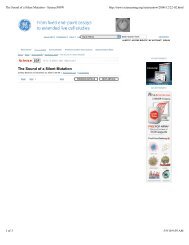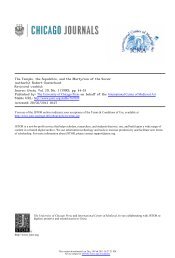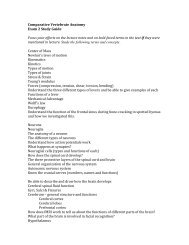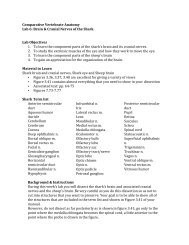K. Stowasser, "Manners and Customs," - Courses
K. Stowasser, "Manners and Customs," - Courses
K. Stowasser, "Manners and Customs," - Courses
You also want an ePaper? Increase the reach of your titles
YUMPU automatically turns print PDFs into web optimized ePapers that Google loves.
<strong>Manners</strong> <strong>and</strong> <strong>Customs</strong> at the Mamluk Court<br />
Author(s): Karl <strong>Stowasser</strong><br />
Source: Muqarnas, Vol. 2, The Art of the Mamluks (1984), pp. 13-20<br />
Published by: BRILL<br />
Stable URL: http://www.jstor.org/stable/1523052<br />
Accessed: 23/01/2010 23:35<br />
Your use of the JSTOR archive indicates your acceptance of JSTOR's Terms <strong>and</strong> Conditions of Use, available at<br />
http://www.jstor.org/page/info/about/policies/terms.jsp. JSTOR's Terms <strong>and</strong> Conditions of Use provides, in part, that unless<br />
you have obtained prior permission, you may not download an entire issue of a journal or multiple copies of articles, <strong>and</strong> you<br />
may use content in the JSTOR archive only for your personal, non-commercial use.<br />
Please contact the publisher regarding any further use of this work. Publisher contact information may be obtained at<br />
http://www.jstor.org/action/showPublisher?publisherCode=bap.<br />
Each copy of any part of a JSTOR transmission must contain the same copyright notice that appears on the screen or printed<br />
page of such transmission.<br />
JSTOR is a not-for-profit service that helps scholars, researchers, <strong>and</strong> students discover, use, <strong>and</strong> build upon a wide range of<br />
content in a trusted digital archive. We use information technology <strong>and</strong> tools to increase productivity <strong>and</strong> facilitate new forms<br />
of scholarship. For more information about JSTOR, please contact support@jstor.org.<br />
http://www.jstor.org<br />
BRILL is collaborating with JSTOR to digitize, preserve <strong>and</strong> extend access to Muqarnas.
KARL STOWASSER<br />
Egypt had just thwarted another invasion of a Cru-<br />
sader army, the second within thirty years, when,<br />
on 2 May 1250, Mamluk troops staged their coup<br />
d'etat in Cairo. It was a time of grave peril for<br />
Islam. Emboldened by the obvious success of the<br />
reconquista in the west, Christendom had for some<br />
time entertained a most audacious plan. Relying<br />
more on rumor <strong>and</strong> wishful thinking than on<br />
knowledge of the geopolitical <strong>and</strong> geographic real-<br />
ities, they hoped for the conquest <strong>and</strong> occupation<br />
of Egypt <strong>and</strong> a link, at Aswan, with the Christian<br />
powers of Nubia <strong>and</strong> Ethiopia, in alliance, perhaps,<br />
with the Mongol heathens. The terrifying Mongol<br />
armies had already brought ruin <strong>and</strong> destruction to<br />
vast portions of the Eastern Caliphate <strong>and</strong> reduced<br />
the most powerful Muslim state of the day, the<br />
empire of the Anatolian Seljuqs, to the status of a<br />
protectorate. The Christians hoped for no less, in<br />
short, than the elimination, once <strong>and</strong> for all, of<br />
Islam.<br />
None of this came about, of course. A mere<br />
decade later, Mamluk troops had brought the tide<br />
of the seemingly invincible Mongol hordes to a halt<br />
in Galilee, <strong>and</strong> before the century was over they<br />
had driven the last remnants of the Crusader army<br />
from Muslim soil. The Mamluk slave warriors,<br />
with an empire extending from Libya to the<br />
Euphrates, from Cilicia to the Arabian Sea <strong>and</strong> the<br />
Sudan, remained for the next two hundred years<br />
the most formidable power of the eastern Mediter-<br />
ranean <strong>and</strong> the Indian Ocean-champions of Sunni<br />
orthodoxy, guardians of Islam's holy places, their<br />
capital, Cairo, the seat of the Sunni caliph <strong>and</strong> a<br />
magnet for scholars, artists, <strong>and</strong> craftsmen uproot-<br />
ed by the Mongol upheaval in the east or drawn to<br />
it from all parts of the Muslim world by its wealth<br />
<strong>and</strong> prestige. Under their rule, Egypt passed<br />
through a period of prosperity <strong>and</strong> brilliance<br />
<strong>Manners</strong> <strong>and</strong> <strong>Customs</strong> at the<br />
Mamluk Court<br />
unparalleled since the days of the Ptolemies. The<br />
titles <strong>and</strong> honorifics of their sultans reflected pride<br />
in their achievements: "pillar of the world <strong>and</strong> of<br />
the faith, sultan of Islam <strong>and</strong> of the Muslims, lord<br />
of kings <strong>and</strong> sultans, slayer of infidels <strong>and</strong> poly-<br />
theists, supporter of the truth, helper of mankind,<br />
ruler of the two seas, lord of the qibla <strong>and</strong> servant<br />
of the Holy Places, reviver of the illustrious caliph-<br />
ate, the shadow of God on earth, partner of the<br />
Comm<strong>and</strong>er of the Faithful, Baybars, son of 'Abd-<br />
Allah, the former slave of al-$alih, may God<br />
strengthen his authority."<br />
They ruled as a military aristocracy, aloof <strong>and</strong><br />
almost totally isolated from the native population,<br />
Muslim <strong>and</strong> non-Muslim alike, <strong>and</strong> their ranks had<br />
to be replenished in each generation through fresh<br />
imports of slaves from abroad. Only those who had<br />
grown up outside Muslim territory <strong>and</strong> who<br />
entered as slaves in the service either of the sultan<br />
himself or of one of the Mamluk amirs were eligible<br />
for membership <strong>and</strong> careers within their closed<br />
military caste. The offspring of mamluks were free-<br />
born Muslims <strong>and</strong> hence excluded from the system;<br />
they became the awlad al-nas, the "sons of respect-<br />
able people," who either fulfilled scribal <strong>and</strong> admin-<br />
istrative functions or served as comm<strong>and</strong>ers of the<br />
non-Mamluk zalqa troops. The exceptions were the<br />
sultans' sons, who for the sake of stability were<br />
allowed to succeed their fathers in the post of chief<br />
mamluk; beginning with Sultan Qala'un al-Alfi<br />
(1279-90), <strong>and</strong> until the end of the "Turkish<br />
period" in 1382, the empire was ruled by a Mamluk<br />
royal dynasty.<br />
Some two thous<strong>and</strong> slaves were imported<br />
annually: Qipchaq, Azeri, <strong>and</strong> Uzbek Turks,<br />
Mongols, Avars, Circassians, Georgians, Arme-<br />
nians, Greeks, Bulgars, Albanians, Serbs, Hun-<br />
garians. Sultan Lajin (1297-99) apparently came<br />
13
14<br />
from the Baltic area; the father of Sultan Barquq<br />
(1382-89, 1390-99) was a peasant in the Danube<br />
region. Khan Masrur was the slave market in<br />
Cairo, <strong>and</strong> a year-round market solely for Mongol<br />
slaves was maintained in Alex<strong>and</strong>ria. Genoese <strong>and</strong><br />
Venetian traders vied with each other as chief sup-<br />
pliers. Up to 100,000 dirhams, we are told, were<br />
paid toward the purchase of a single slave; the<br />
maintenance costs for the slaves amounted to<br />
70,000 dirhams per month during al-Nasir<br />
Mubammad's second reign (1299-1309) <strong>and</strong> had<br />
more than tripled by the time his son al-Hasan<br />
ascended the throne in 1347. Exaggerated as these<br />
figures may seem, there can be no doubt that the<br />
number of slave warriors owned by an amir-his<br />
tulb-meant not only strength <strong>and</strong> prestige, but<br />
often survival in the almost continual power strug-<br />
gle within the Mamluk system. In Qala'un's words,<br />
"All kings have done something for which they are<br />
remembered. Some amassed treasures, others<br />
erected edifices. I have built 'walls' <strong>and</strong> 'strong-<br />
holds' for myself <strong>and</strong> my descendants-the<br />
Mamluks."<br />
Most of the slaves, especially the Qipchaq<br />
Turks, were brought in while still at a young <strong>and</strong><br />
malleable age. After assignment to barracks-there<br />
were twelve of these tibaq in the Citadel alone, each<br />
comprising several buildings <strong>and</strong> accommodating<br />
about a thous<strong>and</strong> mamluks-they received instruc-<br />
tion in Muslim faith <strong>and</strong> practice, including some<br />
rudiments of Islamic jurisprudence, by selected<br />
members of the indigenous clergy. Their com-<br />
m<strong>and</strong>ant was the muqaddam al-mamalik; their<br />
supervisors were palace eunuchs. During their<br />
training period, they received monthly stipends<br />
ranging from three to ten dinars, in addition to<br />
food rations <strong>and</strong> clothing allowances. Discipline<br />
was strict; all contact with the local population was<br />
prohibited. Qala'un's mamluks were not allowed to<br />
leave the Citadel at any time. The rules were some-<br />
what relaxed under al-Ashraf Khalil (1290-94),<br />
who granted occasional daytime leaves, only to be<br />
tightened again by al-NaSir Mubammad, whose<br />
mamluks, by rotation, were marched under the<br />
close supervision of their eunuchs to a weekly bath<br />
in town. Such iron discipline carried over into<br />
palace service later on: amirs <strong>and</strong> mamluks in<br />
attendance on the sultan were not permitted to<br />
speak to each other, nor as much as exchange a<br />
glance. Joint excursions by two or more royal<br />
mamluks, on a hunting trip, for instance, were not<br />
only discouraged, but could mean banishment from<br />
court <strong>and</strong> even more drastic punishment for those<br />
involved, had they failed to obtain the sultan's<br />
MUQARNAS<br />
prior permission. On the other h<strong>and</strong>, the sultans as<br />
a rule lavished every attention on the well-being of<br />
their mamluk trainees. Qala'un even went to the<br />
length of periodically inspecting <strong>and</strong> tasting their<br />
food in person.<br />
Toward the end of the fourteenth century, the<br />
steady supply of young slaves began to dry up,<br />
owing to the upheavals caused by Tamerlane's<br />
invasions in the east <strong>and</strong> demographic changes in<br />
the Qipchaq steppe, <strong>and</strong> the system found itself<br />
compelled to fill the ranks with mostly adult<br />
mamluks from other parts-"ex-sailors, bakery<br />
helpers, water carriers, <strong>and</strong> their ilk," in the words<br />
of the contemporary historian Maqrizi-who were<br />
neither capable nor willing to fit into this strict<br />
regimen. Rules had to be relaxed, the st<strong>and</strong>ards<br />
of training lowered, <strong>and</strong>, by the time of the<br />
second reign of Sultan al-NaSir Faraj (1405-12),<br />
the royal mamluks, once the elite, had become an<br />
impoverished, despicable, ignorant rabble, "more<br />
promiscuous than monkeys," laments Maqrizi,<br />
"more larcenous than mice, more destructive than<br />
wolves."<br />
In the earlier system, once the young trainees<br />
had reached a certain age, instruction in the<br />
martial arts was added to their curriculum: fighting<br />
with lance <strong>and</strong> spear, sword <strong>and</strong> dagger; archery;<br />
<strong>and</strong>, above all, horsemanship. These skills were<br />
then constantly honed, not only in routine practice<br />
on their barracks grounds, but in frequent contests<br />
under the eyes of the sultan on specially designated<br />
<strong>and</strong> prepared fields (mayadln), such as the Midan<br />
al-Kabir below the Citadel, the Midan al-Qabaq<br />
east of Cairo, the Midan al-NaSiri in the area now<br />
occupied by Garden City <strong>and</strong> Tabrir Square, <strong>and</strong><br />
the Midan Siryaqus north of Cairo. There the<br />
mamluks <strong>and</strong> their amirs would demonstrate their<br />
military prowess <strong>and</strong> daredevil horsemanship.<br />
Sultan Baybars al-Bunduqdari (1260-77), a first-<br />
rate archer himself, made qabaq contests-qabaq<br />
(from Turkish qabaq, "pumpkin") designated a<br />
wooden, disk-shaped target mounted on top of a<br />
very tall pole at which the contestants, each lying<br />
supine on the back of a galloping horse, fired their<br />
arrows-a daily afternoon event, <strong>and</strong> later sultans,<br />
Qala'un, Khalil, <strong>and</strong> al-NaSir Mubammad, contin-<br />
ued the practice. The winners were rewarded with<br />
robes of honor or fully bridled <strong>and</strong> caparisoned<br />
horses. Slaves were sometimes given their freedom<br />
on such occasions.<br />
Manumission by the sultan meant integration<br />
into the mamluk comm<strong>and</strong> structure <strong>and</strong> the<br />
beginning of a career in court <strong>and</strong> palace service, in<br />
the military, or as an administrator in the prov-
inces. Advancement <strong>and</strong> promotion depended<br />
almost entirely on the sultan's favor, <strong>and</strong> often his<br />
whim, as did demotion <strong>and</strong> disgrace. There was<br />
little room for friendship in such a system. Even the<br />
camaraderie of the khushdashiyya, that is, slaves<br />
who had served under the same master, seems to<br />
have remained binding only as long as the stakes in<br />
advancement were not too high. At the same time,<br />
the system excluded nepotism <strong>and</strong> favoritism: each<br />
on his own must claw <strong>and</strong> intrigue his way up the<br />
career ladder. Yet in spite of all this competing for<br />
position, the constant realignment of rival factions,<br />
<strong>and</strong> the brutal power struggle that could spill over<br />
into pitched battles in the streets of Cairo, toward<br />
the outside world the mamluks never failed to<br />
display a remarkable esprit de corps, combined<br />
with an aristocratic aloofness. No mamluk would<br />
deign to eat at the same table with "natives," no<br />
matter what their rank <strong>and</strong> station.<br />
Whether in military, administrative, or court<br />
service, the ranks were the same: amir of five, of<br />
ten, of forty, of a hundred. The actual number of<br />
mamluks under the comm<strong>and</strong> of an amir fluctu-<br />
ated. An amir of a hundred, for instance, could be<br />
in charge of as many as five hundred mamluks <strong>and</strong><br />
traditionally had the additional title of "com-<br />
m<strong>and</strong>er of a thous<strong>and</strong>," which designated his func-<br />
tion in times of war. Fiefs, with an annual tax yield<br />
of between more than 200,000 dinars in the case of<br />
senior amirs of a hundred <strong>and</strong> 9,000 dinars or less<br />
for amirs of ten, furnished their material support:<br />
one-third belonged to the fief-holder, two-thirds<br />
was to be set aside for the upkeep <strong>and</strong> equipment<br />
of the mamluks in his charge. Those in court<br />
service were entitled to regular allocations in cash<br />
<strong>and</strong> kind commensurate with their rank, the nature<br />
of their assignment, <strong>and</strong> their degree of closeness to<br />
the sultan. A court assignment could be quite<br />
lucrative, if one played one's cards right. A certain<br />
'All ibn al-Tabbakh, who for thirty-seven years had<br />
faithfully served al-Naiir Mulammad as master of<br />
the table (khwan-salar), left at his death, in addition<br />
to a sizable fortune (the man had drawn five<br />
hundred silver dirhams per day), twenty-five pieces<br />
of real estate in choice locations.<br />
A strictly hierarchical system <strong>and</strong> meticulous<br />
attention to rank <strong>and</strong> status, dress <strong>and</strong> appear-<br />
ance, protocol <strong>and</strong> ceremonial, characterized the<br />
Mamluk regime. This is hardly surprising, given<br />
their diverse ethnic backgrounds <strong>and</strong> their lack of<br />
shared traditions. Some of their offices <strong>and</strong> func-<br />
tions, their customs <strong>and</strong> manners, were obviously<br />
carried over from earlier Islamic practices either in<br />
Egypt or in the Eastern Caliphate; others had dis-<br />
KARL KARL STOWASSER<br />
15<br />
tinctly Asiatic-Turkish, Mongol, Caucasian-<br />
origins. Especially striking is the similarity with<br />
Fatimid institutions. Unlike their former Ayyubid<br />
masters, who, as restorers of orthodox Sunnism,<br />
went out of their way to eradicate the memory of<br />
two hundred years of Shiite rule, the Mamluks felt<br />
free to reach back to the older institutions <strong>and</strong><br />
adapt <strong>and</strong> exp<strong>and</strong> them to suit both their own<br />
needs <strong>and</strong> their role as rulers of Sunni Islam's<br />
supreme power. A minutely organized court<br />
ensured discipline <strong>and</strong> enhanced royal dignity;<br />
pomp <strong>and</strong> ostentation on public occasions were<br />
designed to impress their own subjects as much as<br />
visitors from abroad with the spectacle of regal<br />
splendor <strong>and</strong> military might.<br />
An elaborate, almost modern, protocol gov-<br />
erned the visit of a foreign dignitary or emissary<br />
from the moment he was admitted on Egyptian<br />
soil. In the case of a visiting monarch, the sultan<br />
might himself ride out to meet his guest on his<br />
arrival in Cairo or might delegate a high-ranking<br />
amir, such as the viceroy (na'ib al-saltana) or the<br />
chief chamberlain (ahijib al-bujjab), for that purpose.<br />
The sultan would dismount <strong>and</strong>, after an exchange<br />
of greetings, drape his royal visitor in a robe of silk<br />
brocade; this ceremony was customarily followed<br />
by a large banquet. Lesser dignitaries <strong>and</strong> diplo-<br />
matic emissaries were received by the mihm<strong>and</strong>ar,<br />
the "meeter <strong>and</strong> greeter" of the royal court.<br />
Ranking visitors were accommodated in one of the<br />
royal palaces overlooking the polo field below the<br />
Citadel, envoys <strong>and</strong> lesser dignitaries in the royal<br />
mansion (al-dar al-lultaniyya), a carry-over from<br />
the vizier's residence (dar al-wizara) of Fatimid <strong>and</strong><br />
Ayyubid days. In charge of these guesthouses was<br />
the superintendent of hospitality (nazir al-4iyaifa),<br />
who provided the visitors with horses <strong>and</strong> fodder,<br />
rations <strong>and</strong> money allowances, even female com-<br />
panionship. on occasion. He was likewise<br />
responsible for making out a report on the guests,<br />
for recording the gifts they had brought, <strong>and</strong>, if<br />
they were non-Muslims or came from an enemy<br />
country, for tightening security.<br />
On the day set for the royal audience, the<br />
visitor, previously instructed in the proper eti-<br />
quette, was stripped of his arms <strong>and</strong> ushered by<br />
chamberlains through several anterooms lined with<br />
soldiers to the great portico (?wan) of the Citadel.<br />
On such occasions, the sultan was seated on the<br />
most awesome throne, the takht al-mulk, an ele-<br />
vated structure similar to the pulpit of a mosque,<br />
flanked on either side by the amirs-resplendent in<br />
their finery <strong>and</strong> carefully arranged according to<br />
rank-<strong>and</strong> guarded by the captains of the guard
16 16<br />
MUQARNAS<br />
(ru'us al-nawb). As he approached the sultan, the<br />
visitor, unless he was a king, was expected to kiss<br />
the ground three times, beginning at his end of the<br />
carpet that led to the throne. The katim al-sirr, or<br />
head of the chancery, who had issued the invitation<br />
to the audience, would then formally present him<br />
to the sultan. Only in rare instances was a visitor<br />
allowed to sit in the royal presence. Interpreters<br />
<strong>and</strong> translators would st<strong>and</strong> by to translate docu-<br />
ments <strong>and</strong> act as linguistic intermediaries, although<br />
the sultan rarely addressed a visitor directly.<br />
Rather, he spoke through the mushir, or counselor,<br />
who otherwise acted as the sultan's mouthpiece<br />
during sessions of the royal council (majlis al-<br />
saltana, al-mashwara), a body composed of the<br />
comm<strong>and</strong>er-in-chief of the armed forces (atabeg al-<br />
'asakir) as chairman, the caliph, the vizier in his<br />
capacity as head of the bureaucracy, the justices of<br />
the four orthodox rites, <strong>and</strong> the amirs of a hundred,<br />
which would convene by royal summons to deliber-<br />
ate on vital matters of state, such as war <strong>and</strong> peace.<br />
The reason, we are told, was to safeguard royal<br />
dignity, since the sultan might be overruled by the<br />
council. On the other h<strong>and</strong>, since quite a number of<br />
sultans had only a somewhat shaky comm<strong>and</strong> of<br />
Arabic <strong>and</strong> some of the later ones spoke no Arabic<br />
at all, it may have been deemed wiser that they<br />
open their mouths as little as possible.<br />
The relationship between the sultan <strong>and</strong> the<br />
Abbasid caliph as "partners" remained ambivalent.<br />
While the spiritual weight of the caliph's office was<br />
needed to lend the regime an aura of respectability<br />
<strong>and</strong> legitimacy, its holder could obviously not be<br />
tolerated as co-ruler <strong>and</strong> had to be relegated to a<br />
purely ceremonial function without power. Sultan<br />
Baybars, who in 1261 installed a descendant of the<br />
house of Abbas in Cairo, was the man who estab-<br />
lished the tradition of the monthly audience: on the<br />
first day of every month, the caliph, at the head of<br />
religious dignitaries <strong>and</strong> representatives of the Sufi<br />
orders, would betake himself to the Citadel to<br />
felicitate the sultan on the completion of the month<br />
just past <strong>and</strong> to extend his blessing for the month<br />
to come. When the caliph attended the Friday<br />
prayer, the sultan would assign amirs to escort him<br />
as, riding on a mule, he approached the Great<br />
Mosque of the Citadel. There the sultan would go<br />
forth <strong>and</strong> meet him with every sign of respect <strong>and</strong><br />
honor, even kissing his h<strong>and</strong> at times, <strong>and</strong> invite<br />
him to join him in the royal enclosure. On such<br />
occasions, the caliph would deliver the sermon,<br />
perhaps exhorting the worshipers, at least in the<br />
early years, to join in holy war against the infidel<br />
Mongols <strong>and</strong> Crusaders <strong>and</strong> the heretic Isma'ilis.<br />
Equally fraught with intended symbolism was<br />
the ceremony attending the accession of a new<br />
sultan. Black-signifying the Abbasid caliphate-<br />
was the dominant color as the ruler-to-be, escorted<br />
by the amirs of his retinue on foot, made his way<br />
on horseback from his residence to the great<br />
portico of the Citadel: he wore the takhfifa, a small,<br />
round, black turban, its two ends dangling between<br />
his shoulders (as distinguished from the nauira, an<br />
oversized turban worn, as the equivalent of a<br />
crown, on special ceremonial occasions only), rode<br />
a horse with a black neck caparison <strong>and</strong> saddle<br />
blanket, <strong>and</strong> was flanked by two st<strong>and</strong>ard-bearers<br />
carrying black banners. Heralds (jawishiyya)<br />
cleared the way for the sultan-to-be, who was sur-<br />
rounded by halberdiers (tabardariyya); the shab-<br />
baba, a small silver trumpet, was sounded to<br />
announce his coming, <strong>and</strong> the ghashiya, a highly<br />
ornamented cushionlike saddle cloth of cotton <strong>and</strong><br />
quilted leather, was carried before him as an<br />
emblem of royalty.<br />
Inside, he would take his seat on the imperial<br />
throne, the takht al-mulk, <strong>and</strong> the amirs, in suc-<br />
cession of rank <strong>and</strong> followed by the comm<strong>and</strong>ers of<br />
the tjalqa, or corps of non-Mamluk professional<br />
soldiers, would approach him, first kissing the<br />
ground <strong>and</strong> then his h<strong>and</strong>. (This form of obeisance,<br />
which was to be observed by all except kings who<br />
approached the sultan, survived until the time of<br />
Sultan Barsbay [1422-37], who changed it to a<br />
simple h<strong>and</strong> kiss preceded by a genuflection <strong>and</strong><br />
the placing of a finger on the ground as a symbolic<br />
gesture of ground-kissing.) Next, the caliph made<br />
his appearance <strong>and</strong> joined the sultan on the throne<br />
in order to place the black caliphal robe of honor<br />
(al-khil'a al-khal7fiyya, al-sawad al-khalhfati) over<br />
the sultan's green farajiyya, a flowing, long-sleeved<br />
atlas robe. The head of the chancery then read the<br />
caliph's investiture of the sultan as ruler of the<br />
Muslim territories under Mamluk sway <strong>and</strong> of<br />
l<strong>and</strong>s yet to be conquered from the infidels.<br />
After the formal witnessing of the document<br />
by the four justices <strong>and</strong> an exhortatory speech by<br />
the caliph, the assembled amirs would again kiss<br />
the ground <strong>and</strong> swear on the Koran that they<br />
would not betray or deceive or attack the sultan-<br />
an oath not always kept. The caliph, after having<br />
received tokens of royal favor, shook the sultan's<br />
h<strong>and</strong> <strong>and</strong> departed with the four justices. Robes of<br />
honor-more than twelve hundred at the accession<br />
in 1309 of Sultan Baybars II al-Jashnagir, accord-<br />
ing to Maqrizi--were bestowed on the "men of the<br />
sword" <strong>and</strong> the "men of the pen," who then<br />
paraded, led by the new sultan, through the fes-
tively decorated streets of Cairo. The document of<br />
caliphal investiture, wrapped in a black silk pouch,<br />
was carried ahead of the vizier on the occasion.<br />
The day ended with a royal banquet for the amirs.<br />
Generally, the sultans would spend the<br />
morning hours of each day, except during the<br />
month of Ramadan, attending to state business <strong>and</strong><br />
administrative matters of a more or less routine<br />
nature. The daily morning report (ruq'at al-4abab.)<br />
of the police chiefs of Old <strong>and</strong> New Cairo on fires,<br />
murders, <strong>and</strong> thefts during the past twenty-four<br />
hours would usually be the first item to require<br />
their attention. As a rule, the captain of the guard<br />
(ra's al-nawba) on duty-there were four of them,<br />
one an amir of a hundred <strong>and</strong> three amirs of<br />
forty-would be the first person to see the sultan in<br />
the morning. He had direct access to the sultan at<br />
any time, day or night, <strong>and</strong> enjoyed the distinction<br />
of being addressed by the sovereign as "friend" (ya<br />
akh), rather than the usual ya khund, "lord."<br />
Mondays <strong>and</strong> Thursdays (until the time of<br />
Barquq, who changed the schedule to Sundays <strong>and</strong><br />
Wednesdays, <strong>and</strong> later to Tuesdays <strong>and</strong> Saturdays,<br />
with Friday afternoons thrown in) were set aside<br />
for public audiences-initially held in the House of<br />
Justice (dar al-'adl), that is, the great portico of the<br />
Citadel, <strong>and</strong> at other times at the Courtyard of the<br />
Bench (qa'at al-dikka), the viceroy's residence, or<br />
other places-to hear grievances (qiSa4, maralim), a<br />
practice observed by the rulers of Egypt since the<br />
Tulunids. The sessions were convened in the very<br />
early morning hours, in winter sometimes by torch-<br />
light, <strong>and</strong> presented a veritable tableau of Mamluk<br />
protocol. On such occasions the sultan, since he<br />
was to act as neutral judge, sat on a stool placed<br />
below the imperial throne, or even on the ground,<br />
flanked on his right by the justices of the four rites,<br />
the Shafi'ite as the highest-ranking immediately<br />
next to the sultan, followed in descending order of<br />
rank by the Hanafite, the Malikite, <strong>and</strong> the Hanba-<br />
lite representatives, <strong>and</strong> next, in succession, the<br />
secretary (wakl) of the treasury <strong>and</strong> the superin-<br />
tendent of the prefecture of Cairo. On the sultan's<br />
left sat the head of the chancery, <strong>and</strong> opposite him<br />
the superintendent of the army (na;ir al-jaysh), the<br />
superintendent of the privy purse (na;ir al-kha\),<br />
the muftis of the four rites serving as legal experts,<br />
<strong>and</strong> a group of recording scribes (kuttab dast), the<br />
whole forming a circle. If the vizier was one of the<br />
"men of the pen," he would sit between the sultan<br />
<strong>and</strong> the head of the chancery; but if he belonged to<br />
the "men of the sword," he would st<strong>and</strong> at some<br />
distance with the rest of the officers of the house-<br />
hold, as did the viceroy-if there was one present,<br />
KARL KARL STOWASSER STOWASSER 17<br />
since the office was temporarily abolished in 1338<br />
by al-Nasir Mulammad. Behind the sultan, on the<br />
right <strong>and</strong> left, stood two rows of arms-bearers,<br />
masters of the wardrobe, <strong>and</strong> mamluks of the<br />
sultan's entourage (kha agiyya). At a distance of<br />
nine yards on the right <strong>and</strong> left sat the amirs of the<br />
royal council, <strong>and</strong> behind these stood the rest of<br />
the amirs positioned according to rank. Chamber-<br />
lains <strong>and</strong> secretary-bailiffs (dawadars) were sta-<br />
tioned on the outside of the circle to sift <strong>and</strong> pass<br />
on the grievances <strong>and</strong> petitions.<br />
The closest thing to a folksy appearance of the<br />
court in public was the annual celebration of the<br />
Prophet's birthday. Some three hundred to five<br />
hundred porters were needed to erect the gigantic<br />
tent on the Hosh, consisting of four halls topped by<br />
a cupola with vents to let the light in. The sultan<br />
would be seated at the far end of the tent, together<br />
with the caliph, the four justices, the learned<br />
sheikhs, <strong>and</strong> the reciters of the Prophet's story in<br />
poetry <strong>and</strong> prose, as well as ranking members of<br />
the awlad al-nas, amirs, <strong>and</strong> various state function-<br />
aries. Leather tanks filled with sugar water were set<br />
up to provide refreshment for all comers, high <strong>and</strong><br />
low. The celebration would begin in the late after-<br />
noon with readings from the Koran <strong>and</strong> the recital<br />
of poems <strong>and</strong> homilies appropriate to the occasion.<br />
After a joint sunset prayer, a meal <strong>and</strong> seasonal<br />
sweets would be served, <strong>and</strong> the recitals continued.<br />
Around nine o'clock, the various Sufi orders, with<br />
their emblems <strong>and</strong> banners, arrived <strong>and</strong> began their<br />
singing <strong>and</strong> swaying <strong>and</strong> dancing, which would last<br />
throughout the night. Money purses <strong>and</strong> other<br />
tokens of royal favor were bestowed as the night<br />
went on, for the Mamluks were much attracted to<br />
Sufism <strong>and</strong> their sultans were generous sponsors of<br />
its practitioners.<br />
A frequent display of royal bounty was part of<br />
a sultan's duties <strong>and</strong> a way to stay in power: van-<br />
ities had to be flattered, loyalties bought, jealousies<br />
assuaged. Not only did the medieval state feed <strong>and</strong><br />
clothe its servitors, but the bestowal of robes of<br />
honor <strong>and</strong> generous money gifts, the donation of<br />
horses, <strong>and</strong> the extension of other royal favors<br />
accompanied almost every occasion on which the<br />
sultan officiated or even appeared in public. Robes<br />
of honor (khila'), meticulously designed to fit the<br />
recipient's rank <strong>and</strong> station-red over yellow atlas,<br />
for instance, for senior amirs, white silk chenille for<br />
ranking members of the bureaucracy, white wool<br />
for judges <strong>and</strong> ulema-were so frequently <strong>and</strong> com-<br />
monly bestowed (even slavers <strong>and</strong> horse traders<br />
were so rewarded) that their production kept an<br />
entire royal industry busy. Marks of signal distinc-
18<br />
MUQARNAS<br />
tion were the garments that came literally off the<br />
sultan's back, as when he bestowed the robe he<br />
wore during the Little Bairam prayer on one of the<br />
attending senior amirs.<br />
Aside from five regular meals served daily at<br />
the court, three in the morning <strong>and</strong> two in the<br />
evening, there were huge banquets (asmita, wala'im)<br />
on special occasions. The master of the table<br />
(khwan-salar) supervised the preparation of the<br />
food in the royal kitchens, the majordomo-in-<br />
waiting (ustadar al-suhba) acted as a sort of maitre<br />
d'h6tel, a swarm of cupbearers (suqah) headed by<br />
the royal cupbearer (saqi'l-mulk, al-saqi) served<br />
food <strong>and</strong> drink <strong>and</strong> cleared the table afterward, <strong>and</strong><br />
a staff of tasters under the comm<strong>and</strong> of the<br />
jashnagir (the shishni of colloquial Egyptian) stood<br />
by to sample food <strong>and</strong> drink for possible poison.<br />
Guests ate <strong>and</strong> drank from gold, silver, <strong>and</strong> porce-<br />
lain vessels. Although forks <strong>and</strong> spoons were<br />
known, eating was usually done with the fingers,<br />
which were constantly rinsed with water poured<br />
from ewers into large fingerbowls. Truly gargan-<br />
tuan amounts of food might be served: at a<br />
banquet given by al-Ashraf Khalil on the occasion<br />
of the completion of the Ashrafiyya Palace in 1293,<br />
for instance, the guests consumed 3,000 sheep, 600<br />
cows, 500 slaughter horses, <strong>and</strong> countless chickens<br />
<strong>and</strong> geese, not to mention the almost 90,000 kilos<br />
of sugar that went into drinks <strong>and</strong> sweets.<br />
This bash cost the sultan 300,000 gold dinars<br />
alone for food <strong>and</strong> drink, robes of honor, <strong>and</strong> other<br />
royal gifts <strong>and</strong> favors, such as embroidered<br />
material, saddles, dresses for the women, <strong>and</strong> the<br />
like. Several high-ranking amirs received, in addi-<br />
tion, gifts of a thous<strong>and</strong> dinars, thirty of the royal<br />
guard (khassagiyya) received five hundred dinars<br />
each, <strong>and</strong> every amir was given a fully bridled <strong>and</strong><br />
caparisoned horse. Besides, treasury officials scat-<br />
tered gold coins during the circumcision ceremony<br />
for the sultan's younger brother Muhammad <strong>and</strong><br />
his nephew Musa, which was celebrated on the<br />
same occasion, <strong>and</strong> the entertainer of the day, a<br />
singer named al-Bulaybil ("Little Nightingale"),<br />
was paid a thous<strong>and</strong> dinars for his labors. A few<br />
years later, when young Muhammad himself sat on<br />
the throne, he outdid his brother in extravagance<br />
on a similar occasion. For a party he gave in 1314<br />
to celebrate the completion of the Qagr al-Ablaq,<br />
he ran up a bill, if one can believe Maqrizi, of<br />
500,500,000 dirhams.<br />
Horses were a mamluk's prized possession,<br />
<strong>and</strong> to give them as gifts was a favorite way for the<br />
sultan to show his pleasure <strong>and</strong> favor. There were<br />
numerous occasions for it-in the spring, for<br />
instance, when the sultan went out to the royal<br />
paddocks; at the conclusion of military <strong>and</strong> sport-<br />
ing events; at various ceremonial affairs; when the<br />
sultan rode out on the hunt-so that senior amirs<br />
<strong>and</strong> members of the royal entourage might each<br />
receive as many as a hundred horses, some with full<br />
accoutrements, in the course of a year. Al-Nasir<br />
Muhammad, a hippophile of the first order, had<br />
4,800 horses in his stables <strong>and</strong> is said to have spent<br />
one million dirhams in a single day toward the<br />
purchase of Arabian purebreds. As many as eight<br />
hundred functionaries-amirs of ten <strong>and</strong> an assort-<br />
ment of troopers, grooms, veterinarians, <strong>and</strong> the<br />
like-worked in the royal stables. In charge of<br />
them was an amir of a hundred, the amir-akhur, or<br />
equerry, while an amir of forty, the sar-akhur, was<br />
the official responsible for fodder. The sultan's<br />
horses, all br<strong>and</strong>ed with the royal dagh, were not<br />
only walked <strong>and</strong> exercised daily, but occasionally<br />
displayed in horse shows-as in Fatimid times,<br />
before a royal procession, for instance. Moreover,<br />
there were the royal camel pens (manakhat), where<br />
al-Nasir Muhammad kept five thous<strong>and</strong> riding<br />
camels, <strong>and</strong> even stables for elephants.<br />
Seven times in the spring, the sultan, accompa-<br />
nied by the mamluks of his retinue, the majordomo<br />
(ustadar), <strong>and</strong> an assortment of other functionaries,<br />
such as falconers, drivers, animal keepers, <strong>and</strong><br />
physicians, members of his harem, <strong>and</strong> a train of<br />
amirs with their own mamluks, would go on<br />
hunting excursions-any one of which could easily<br />
last for a week. On such occasions he rode an<br />
unadorned horse; no banners <strong>and</strong> st<strong>and</strong>ards were<br />
carried over his head. If the procession passed<br />
through the fief of a senior amir, it was customary<br />
for the local feudatory to supply sheep, geese,<br />
chickens, sugarcane, <strong>and</strong> barley for the hunting<br />
party; the sultan, in turn, would bestow on him 4.2<br />
kilos of gold, a robe of honor, <strong>and</strong> a fully bridled<br />
<strong>and</strong> equipped packhorse with a gold-embroidered<br />
housing (kunbush).<br />
Royal hunting preserves stocked with game<br />
<strong>and</strong> wildfowl, <strong>and</strong> similar preserves of the ranking<br />
amirs, were the hunting grounds. When the hunting<br />
was done with falcons, the sultan would be accom-<br />
panied by the master of the hunt, the amir-shikir,<br />
who directed the falconers, or bazdariyya. Hunting<br />
dogs, decked out for the occasion in gold-<br />
embroidered silk <strong>and</strong> led by the dog-masters<br />
(kilabziyya), were used to hunt ostriches, antelopes,<br />
<strong>and</strong> gazelles, as were trained cheetahs, which had<br />
their own special keepers. Large game was hunted<br />
with javelins, arrows, or crossbows shooting lead,<br />
clay, or stone pellets (qusiyy al-julahiq), birds
usually with a blowgun (zabtana) <strong>and</strong> pellets called<br />
bunduq, which were carried in a sack by a special<br />
official, the bunduqdar. Even away from home <strong>and</strong><br />
roughing it, the comforts of life were not forgotten:<br />
at the end of a day's hunt they could return to fully<br />
furnished <strong>and</strong> carpeted tents attended by a myriad<br />
of servants, enjoy the pleasure of a leisurely bath in<br />
wooden tubs, <strong>and</strong> eat well-prepared meals from<br />
lead camping dishes.<br />
Numerous occasions throughout the year<br />
called for royal processions. Some were minutely<br />
designed to bring out the full panoply of royal <strong>and</strong><br />
Mamluk splendor, such as the processions on the<br />
two highest Islamic festivals or during the annual<br />
parade of the mahmil in the streets of Cairo in prep-<br />
aration for the pilgrimage; others were relatively<br />
low-key, as the weekly procession to Friday prayer<br />
or the procession on the occasion of the annual<br />
"anointing of the Nilometer" (takhliq al-miqyas)<br />
<strong>and</strong> "breaking of the dam" (kasr al-sadd) to mark<br />
the opening of the irrigation season. A full-dress<br />
procession must have been a colorful spectacle<br />
indeed: ahead rode two files of rikabdariyya, or<br />
stirrup holders, under the comm<strong>and</strong> of the amir-<br />
j<strong>and</strong>ar, the man responsible for the sultan's safety,<br />
to clear the road. They flanked others on foot who<br />
carried the gilded <strong>and</strong> gem-encrusted saddle cloth,<br />
the ghashiya, which they waved from side to side.<br />
Behind them rode a horseman who sounded the<br />
royal trumpet (shabbaba), <strong>and</strong> then a pair of<br />
Mamluk squires, al-jiftah, dressed identically in<br />
gold-bordered yellow silk tunics <strong>and</strong> mounted on<br />
identical white horses. Golden ribbons connected<br />
them with the sultan behind them, a safety device<br />
in case the sultan's horse stumbled or shied. Next<br />
came the sultan, riding a gray horse bedecked with<br />
a gold-embroidered neck caparison (raqaba) of<br />
yellow atlas-yellow being the color of Mamluk<br />
royalty-<strong>and</strong> a red atlas cloth, called zunnari, over<br />
the croup. A senior amir riding by his side held the<br />
royal parasol (jatar) of yellow silk above the<br />
sultan's head, while halberdiers on foot, com-<br />
m<strong>and</strong>ed by the amir-tabar, surrounded him on all<br />
sides as bodyguards. By his side strode the jumaq-<br />
dar, or mace-bearer, his eyes fixed on his lord,<br />
holding the gold-tipped mace aloft, <strong>and</strong> the jukan-<br />
dar, or polo master, carrying the royal curved<br />
dagger (nimja) <strong>and</strong> a steel buckler. At times, the<br />
chief chamberlain carrying a staff of office, or the<br />
treasurer (khazindar) lugging a sack of money<br />
intended for charity would precede the sultan.<br />
Behind the sultan, a group of squires led royal<br />
horses covered with richly embroidered <strong>and</strong> gem-<br />
studded housings. Then followed the st<strong>and</strong>ard<br />
KARL STOWASSER '9 19<br />
bearers, headed by the 'alamdar who carried the<br />
great royal banner (jalish) of gold-embroidered<br />
yellow silk adorned with a tuft of horsehair, <strong>and</strong><br />
behind them the armor bearers headed by the silah-<br />
dar. The amirs, on horseback or on foot, came next<br />
with their retinue of mamluks, in similar order <strong>and</strong><br />
with hardly less pomp, <strong>and</strong> the tail end was<br />
brought up by the royal b<strong>and</strong>, al-tablkhana al-<br />
sharifa, an ensemble more noisy than melodious,<br />
composed of four big drums, forty brass cymbals,<br />
four double-reed clarinets, <strong>and</strong> twenty small kettle-<br />
drums.<br />
It was Sultan al-Nasir Muhammad who made<br />
polo games twice a week, at noon on Tuesdays <strong>and</strong><br />
Saturdays, an obligatory part of Mamluk court<br />
ritual. The two teams were captained by the sultan<br />
<strong>and</strong> the comm<strong>and</strong>er-in-chief of the troops. At the<br />
end of the games, the sultan would reward the<br />
players as well as the polo master <strong>and</strong> his helpers<br />
with robes of honor. Horse races, not surprisingly,<br />
were a favorite pastime of the Mamluk elite. A<br />
hundred <strong>and</strong> fifty horses, or even more, at a time<br />
could be on the starting line. The race was between<br />
the sultan's horses <strong>and</strong> those of the amirs. The<br />
horses raced between two marble columns, the<br />
'awamid al-sibaq, erected on either end of the field,<br />
<strong>and</strong> were usually ridden by bedouin jockeys. The<br />
owners of the winners were rewarded with horses<br />
<strong>and</strong> robes of honor. As on other occasions, such as<br />
martial exercises or wrestling displays, betting was<br />
encouraged.<br />
Despite the role they played as guardians of<br />
religious decency <strong>and</strong> sponsors of the Islamic estab-<br />
lishment, the Mamluks rarely let religion interfere<br />
with their personal ambitions <strong>and</strong> pleasures. They<br />
did their drinking-except during Ramadan, of<br />
course-unabashedly in public: fermented mare's<br />
milk (qimizz), the drink of their Asian homel<strong>and</strong>;<br />
buza, a brew made from flour <strong>and</strong> fermented date<br />
juice; <strong>and</strong> mizr, a beerlike wheat or barley brew as<br />
old as Egypt. Although Baybars at one point<br />
cracked down on vice <strong>and</strong> immorality <strong>and</strong> had all<br />
breweries in Cairo destroyed, liquor concessions<br />
remained on the whole an important tax source.<br />
The Mamluks liked a good songfest in the Citadel<br />
<strong>and</strong> showered lavish rewards on the top enter-<br />
tainers, just as they enjoyed the performance <strong>and</strong><br />
company of belly dancers, most of them Jewish <strong>and</strong><br />
Armenian girls, some of whom they even brought<br />
into their retinues. And at celebrations like wed-<br />
dings <strong>and</strong> circumcisions, the royal mamluks <strong>and</strong><br />
their amirs did not mind joining the fun <strong>and</strong> doing<br />
a bit of dancing themselves.<br />
With all their general aloofness <strong>and</strong> isolation
20<br />
MUQARNAS<br />
from the indigenous population, there were times at<br />
which the court <strong>and</strong> the great feudal lords showed<br />
generosity to their Muslim <strong>and</strong> non-Muslim sub-<br />
jects, as when they provided free public meals on<br />
the two great Muslim holidays, the 'Id al-Fitr <strong>and</strong><br />
the 'Id al-Adha, or contributed food <strong>and</strong> money<br />
when their Coptic employees celebrated their New<br />
Year (nawruz) in early September. Until the public<br />
celebration of the latter was banned by Sultan<br />
Barquq in 1385, the court would even put a state<br />
representative, the amir al-nawruz, in charge of the<br />
festivities, which sometimes were attended by the<br />
sultan himself. But such tokens of Mamluk benevo-<br />
lence <strong>and</strong> interreligious harmony had already been<br />
seriously threatened by the time of Barquq. Thirty-<br />
one years earlier, Sultan $alah al-Din Salih (1351-<br />
54), amid a wave of anti-Christian sentiment, had<br />
altogether abolished a festival that used to bring<br />
non-Muslims <strong>and</strong> Muslims together: the tradi-<br />
tional Coptic Feast of the Martyr, celebrated for<br />
three days beginning on 18 or 19 May. The immer-<br />
sion of a box containing a martyr's finger in the<br />
Nile in anticipation of the river's annual rise was<br />
deemed pagan <strong>and</strong> offensive; besides, the people<br />
had the habit of drinking themselves silly on the<br />
occasion. And four years later, his brother al-<br />
Hasan, much in the same vein, had put a ban on<br />
the public celebration of Coptic Christmas on 7<br />
January.<br />
UNIVERSITY OF MARYLAND<br />
COLLEGE PARK<br />
NOTE<br />
The sources on which this chapter is based are al-<br />
Maqrizi (Taqiy al-Din Abu 'l-'Abbas Abmad b. 'All),<br />
Al-Mawa'i; wa-'l-i'tibar fi dhikr al-khitat wa-'l-athar<br />
(Bulaq, 1270/1853) <strong>and</strong> Kitab al-suluk li-ma'rifat duwal<br />
al-muluk, ed. Ziyada/'Ashur (Cairo, 1956-73); al-<br />
Qalqash<strong>and</strong>i (Abu 'l-'Abbas Abmad b. 'AlI), $ubh al-a'sha<br />
fti ina'at al-insha (Cairo, 1383/1963); Ibn Taghribirdi<br />
(Jamal al-Din Abu 'l-Mabasin Yusuf), Al-Nujfm al-zahira<br />
fi muluk Misr wa-'l-Qahira (Cairo, 1383-92/1963-72); Ibn<br />
Iyas (Muhammad b. Ahmad), Badi'i' al-zuhfir fi waqa'i'<br />
al-duhur, ed. Mostafa (Cairo, 1960-75); Ibn Shahin<br />
(Ghars al-Din Khalil), Zubdat kashf al-mamalik wa-bayan<br />
al-turuq wa-'l-masalik, ed. Ravaisse (Paris, 1891); <strong>and</strong> al-<br />
'Umari (Shihab al-Din Abmad b. Yabya b. Fall-Allah),<br />
Al-Ta'rif bi- '-musalab al-sharf (Cairo, 1312/1894}.















